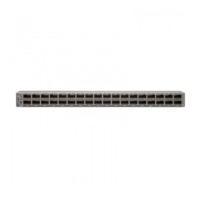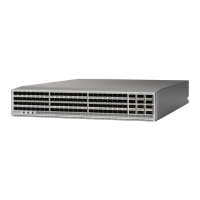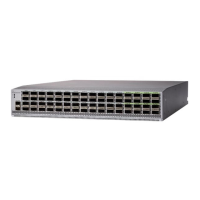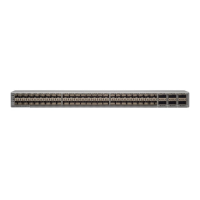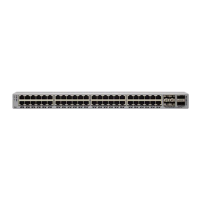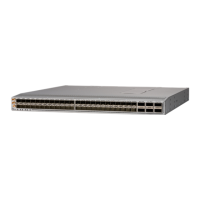Do you have a question about the Cisco Nexus 9332D-GX2B and is the answer not in the manual?
Provides an overview of the Cisco Nexus 9332D-GX2B switch, its ports, and role considerations.
Details methods for discovering the switch within the ACI fabric, including APIC and spine discovery.
Lists fan and power supply modules with their airflow choices and specifications.
Specifies the acceptable ambient operating and non-operating temperature ranges for the switch.
Outlines humidity levels for switch operation and the use of dehumidifiers if necessary.
States the altitude rating for the switch installation, with specific values for China.
Details precautions to prevent dust and particle contamination for optimal switch operation.
Provides guidelines to reduce EMI/RFI, including using shielded cables and filler plates.
States that the switch is tested for shock and vibration according to operating, handling, and earthquake standards.
Explains the necessity of earth-ground connection for voltage protection and proper grounding methods.
Details the switch's power supply configuration, typically two 1500W AC or two 1100W DC supplies.
Describes port-side intake and exhaust airflow, and identifies airflow direction by module coloring.
Specifies requirements for standard perforated, solid-walled, and open four-post Telco racks.
Details necessary clearance around the chassis for installation, cabling, airflow, and maintenance.
Provides critical safety instructions and definitions for personnel working with the equipment.
Details available rack-mount kits for installing the switch in racks of varying depths.
Explains how to position the switch and modules for correct airflow based on aisle configuration.
Provides general guidelines for switch installation, including clearance, grounding, and power.
Guides on how to unpack and inspect the switch for damage or missing components.
Step-by-step instructions for installing the switch using the NXK-ACC-KIT-1RU rack-mount kit.
Details the installation procedure for the N9K-AIRFLOW-SLV airflow sleeve.
Explains how to properly ground the switch chassis for safety and electrical continuity.
Guides on connecting the switch to power and verifying operational status.
Describes the components of the ACI fabric, including APICs, leaf, and spine switches.
Details considerations for connecting fabric devices, including cabling, distance, and equipment.
Explains how to connect Cisco Nexus 9300 ACI-mode leaf switches to APICs using specific VIC modules.
Details how to connect leaf switches to every spine switch for optimal forwarding in the ACI fabric.
Provides steps to migrate Cisco Nexus 9000 switches from first to second generation.
Guides on setting up a console interface for initial switch configuration using the accessory kit.
Explains how to set up an out-of-band management connection for monitoring and troubleshooting.
Provides guidelines for keeping transceivers and fiber-optic cables clean and dust-free for signal accuracy.
Details the procedure for replacing a fan module while the switch is operating.
Explains how to replace power supply modules, ensuring matching airflow and power source types.
Provides step-by-step instructions for safely removing a fan module from the chassis.
Guides on how to install a new fan module, ensuring correct alignment and LED status.
Details the steps to disconnect and remove an AC power supply module from the chassis.
Outlines the procedure to disconnect and remove a DC power supply module from the chassis.
Guides on installing a new AC power supply, ensuring matching airflow and power source types.
Provides instructions for installing a new DC power supply, ensuring correct airflow and power source.
Describes the types of cabinets and racks suitable for switch installation, including perforated and open racks.
Specifies general requirements for cabinets and racks, including 19-inch EIA standards and mounting rails.
Details minimum vertical rack space and clearance requirements for mounting the chassis in open racks.
Outlines perforation requirements for front/rear doors and roof for optimal cooling in perforated cabinets.
Offers advice on managing cables within the rack for easier routing and access.
Lists operating and non-operating temperature, humidity, and altitude ratings for the switch.
Provides the physical dimensions (width, depth, height) of the Cisco Nexus 9332D-GX2B switch.
Lists the weight and quantity for the chassis, fan modules, and power supplies.
Provides a link to view transceiver and cable specifications and compatibility information.
Details the typical and maximum power consumption and heat dissipation for the switch.
Introduces specifications for each type of power supply module used with the switch.
Lists the electrical characteristics of the 1100-W DC power supply.
Details the electrical characteristics and efficiency rating of the 1500-W AC power supply.
Specifies the power cables that can be ordered and used with the switch.
Lists part numbers and descriptions for DC power cables.
Lists safety and EMC compliance standards for the switch.
Describes the BCN, STS, and ENV LEDs on the front of the switch and their status indications.
Details the status LED on the fan module and its operational meanings.
Explains the OK and FAIL LEDs on the power supply, indicating status and potential issues.
Lists and illustrates the contents of the 1-RU rack-mount kit, including brackets and screws.
Illustrates and lists the airflow sleeve (N9K-AIRFLOW-SLV) for proper switch cooling.
Provides an overview of the Cisco Nexus 9332D-GX2B switch, its ports, and role considerations.
Details methods for discovering the switch within the ACI fabric, including APIC and spine discovery.
Lists fan and power supply modules with their airflow choices and specifications.
Specifies the acceptable ambient operating and non-operating temperature ranges for the switch.
Outlines humidity levels for switch operation and the use of dehumidifiers if necessary.
States the altitude rating for the switch installation, with specific values for China.
Details precautions to prevent dust and particle contamination for optimal switch operation.
Provides guidelines to reduce EMI/RFI, including using shielded cables and filler plates.
States that the switch is tested for shock and vibration according to operating, handling, and earthquake standards.
Explains the necessity of earth-ground connection for voltage protection and proper grounding methods.
Details the switch's power supply configuration, typically two 1500W AC or two 1100W DC supplies.
Describes port-side intake and exhaust airflow, and identifies airflow direction by module coloring.
Specifies requirements for standard perforated, solid-walled, and open four-post Telco racks.
Details necessary clearance around the chassis for installation, cabling, airflow, and maintenance.
Provides critical safety instructions and definitions for personnel working with the equipment.
Details available rack-mount kits for installing the switch in racks of varying depths.
Explains how to position the switch and modules for correct airflow based on aisle configuration.
Provides general guidelines for switch installation, including clearance, grounding, and power.
Guides on how to unpack and inspect the switch for damage or missing components.
Step-by-step instructions for installing the switch using the NXK-ACC-KIT-1RU rack-mount kit.
Details the installation procedure for the N9K-AIRFLOW-SLV airflow sleeve.
Explains how to properly ground the switch chassis for safety and electrical continuity.
Guides on connecting the switch to power and verifying operational status.
Describes the components of the ACI fabric, including APICs, leaf, and spine switches.
Details considerations for connecting fabric devices, including cabling, distance, and equipment.
Explains how to connect Cisco Nexus 9300 ACI-mode leaf switches to APICs using specific VIC modules.
Details how to connect leaf switches to every spine switch for optimal forwarding in the ACI fabric.
Provides steps to migrate Cisco Nexus 9000 switches from first to second generation.
Guides on setting up a console interface for initial switch configuration using the accessory kit.
Explains how to set up an out-of-band management connection for monitoring and troubleshooting.
Provides guidelines for keeping transceivers and fiber-optic cables clean and dust-free for signal accuracy.
Details the procedure for replacing a fan module while the switch is operating.
Explains how to replace power supply modules, ensuring matching airflow and power source types.
Provides step-by-step instructions for safely removing a fan module from the chassis.
Guides on how to install a new fan module, ensuring correct alignment and LED status.
Details the steps to disconnect and remove an AC power supply module from the chassis.
Outlines the procedure to disconnect and remove a DC power supply module from the chassis.
Guides on installing a new AC power supply, ensuring matching airflow and power source types.
Provides instructions for installing a new DC power supply, ensuring correct airflow and power source.
Describes the types of cabinets and racks suitable for switch installation, including perforated and open racks.
Specifies general requirements for cabinets and racks, including 19-inch EIA standards and mounting rails.
Details minimum vertical rack space and clearance requirements for mounting the chassis in open racks.
Outlines perforation requirements for front/rear doors and roof for optimal cooling in perforated cabinets.
Offers advice on managing cables within the rack for easier routing and access.
Lists operating and non-operating temperature, humidity, and altitude ratings for the switch.
Provides the physical dimensions (width, depth, height) of the Cisco Nexus 9332D-GX2B switch.
Lists the weight and quantity for the chassis, fan modules, and power supplies.
Provides a link to view transceiver and cable specifications and compatibility information.
Details the typical and maximum power consumption and heat dissipation for the switch.
Introduces specifications for each type of power supply module used with the switch.
Lists the electrical characteristics of the 1100-W DC power supply.
Details the electrical characteristics and efficiency rating of the 1500-W AC power supply.
Specifies the power cables that can be ordered and used with the switch.
Lists part numbers and descriptions for DC power cables.
Lists safety and EMC compliance standards for the switch.
Describes the BCN, STS, and ENV LEDs on the front of the switch and their status indications.
Details the status LED on the fan module and its operational meanings.
Explains the OK and FAIL LEDs on the power supply, indicating status and potential issues.
Lists and illustrates the contents of the 1-RU rack-mount kit, including brackets and screws.
Illustrates and lists the airflow sleeve (N9K-AIRFLOW-SLV) for proper switch cooling.
